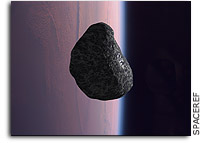NEO News (05/02/07) White Paper from AIAA Planetary Defense Conference

Below are the main recommendations from the Planetary Defense Conference, held in March. The full text of this White Paper has been posted at the conference web site, http://www.aero.org/conferences/planetarydefense/2007papers.html
David Morrison
2007 PLANETARY DEFENSE CONFERENCE: SUMMARY WHITE PAPER
George Washington University, March 5-8, 2007
The meeting was attended by 145 participants. Copies of papers, presentation material, and videos of the presentations themselves are available at the conference web site, www.aero.org/conferences/planetarydefense.
Meeting Structure
Day 1 of the conference provided an overview of efforts to discover threatening Near Earth Objects (NEOs), defined as asteroids or comets whose orbits have perihelia of less than 1.3 Astronomical Units (AU), and the subset of NEOs that pose a more immediate threat to Earth, called Potentially Hazardous Objects (PHOs). PHOs are defined as asteroids and comets that pass within 0.05 AU of Earth’s orbit and are large enough to cause significant damage should one impact Earth (~50 meters in diameter and larger). Day 1 presenters also discussed what we know about the composition and structure of PHOs, how such characteristics are determined, and what has been learned from recent missions to, and observations of, asteroids and comets. Briefings included a summary of the detection and characterization aspects of the recently completed study by NASA in response to congressional direction. Information was also presented on NEO/PHO populations, the potential increases in their rates of discovery, and the variation of impact probability as the number of observations increases.
Presenters in Day 2 discussed techniques that could be used to deflect or otherwise mitigate a threatening asteroid and the design of deflection and mitigation missions. Presentations highlighted how NEO composition and structure influence the effectiveness of mitigation techniques, described slow-push and quick-impulse deflection methods, and proposed techniques that could be used to break a threatening object into small fragments. Presenters also gave an overview of missions that have been proposed to actually test our ability to move an asteroid. Included in Day 2 was the presentation of deflection technique-related highlights of the NASA Report to Congress.
Day 3 summarized recent work on consequences of an impact, including tsunamis and the overpressure developed during a high-speed entry into Earth’s atmosphere. The latter work suggests that treating airbursts as point-source explosions may not provide the most accurate estimates of surface effects from NEO entries. Likely, hypothetical reactions of disaster and emergency response agencies and the public to warnings or to an actual impact were also highlighted using lessons learned from recent hurricane and tsunami-related disasters.
On Day 4, the final day, a panel of experts discussed topics such as legal issues associated with testing and implementing deflection techniques, educational aspects of NEO impact protection, and maintaining funding for an ongoing, long-term level of effort on detection, characterization and deflection. The panel also reported on ongoing efforts to develop an international decision process for NEO deflection. A second panel, made up of session chairs, discussed key points raised in each session. Meeting attendees were invited to address both panels.
After the meeting, key points discussed by presenters and participants were distilled and refined by the conference’s steering committee and circulated to all conference attendees for comment and discussion. Resulting consensus findings and recommendations are collected in this document.
Findings and Recommendations
While significant scientific and technological advances have been made since the 2004 conference and are ongoing, it is clear that providing effective planetary defense from Near Earth Objects and planning for mitigation of an impact disaster are in their infancy. Specifically, the primary findings of the conference are that:
1. While our search and discovery efforts have successfully found most of the large, “civilization-killer” 1-km and larger objects, we are just beginning to find the much more prevalent and, for that reason, more frequently dangerous objects in the 140- to 300-meter size range. An impact by an object in this size range could occur with little or no warning and could cause serious loss of life and property over a broad area.
2. Earth-based resources such as the Arecibo radar are critical for refining a PHO’s orbit and providing basic information required for deflection. Arecibo has an essential role in refining the threat posed by PHOs such as Apophis.
3. Deflection of a threatening object is in the conceptual phase. We are just beginning to identify the options available to deflect an object and have yet to design or test techniques that might be used. Further, we have yet to design complete missions to deliver one or more deflection devices, and have not considered what is required to assure a high probability of success for an overall deflection campaign.
4. There are serious technical, political, policy, legal and societal issues involved in deciding whether and how to respond to a threat of a NEO impact. NEO impacts have the potential to cause disasters that would equal or exceed anything ever faced by recent civilizations. Moreover, this type of threat has never been seriously considered by any agencies that would have responsibility for responding. In addition, it is uncertain where responsibility for coordination of all aspects of the NEO threat lies, from detection to deflection to impact aftermath.
5. Understanding, analyzing, and dealing with a potential NEO threat is an international problem demanding international cooperation. Considerable work is required to develop a foundation for international cooperation and action in all areas related to planetary defense. This foundation may extend beyond defense and include benefits from international manned and unmanned space exploration.
The remainder of this White Paper provides background and recommendations in five areas considered at the conference: Detection and Characterization; Deflection Approaches and Missions; Impact Consequences and Response; Political, Policy, Legal; and Public Perception and Trust.








